It’s been over ten years since we visited the fouled domain of the Phyrexians in New Phyrexia. They’ve been popping up here and there ever since, offering up tantalizing glances at their manipulations and schemes. But now it’s time to return to New Phyrexia to bear witness to their grotesque creations and to prostrate ourselves before their immaculately compleated glory.
I am supremely excited - maybe even compleatly excited - for Phyrexia: All Will Be One. Magic is appealing to me for a variety of reasons, but one of the strongest is the sheer imagination of the worlds in play. Add in my long-standing appreciation for horror, and it’s easy to see why I’m raring to rip open packs of ONE. What corruption will be found inside? Let’s take a look!
Mechanics and Themes
Poison Counters

Poison is a signature Phyrexian mechanic. It works like this: various creatures and spells may cause a player to gain poison counters. And if a player reaches ten poison counters, they lose. It’s a simple and brutal mechanic used in previous sets such as Scars of Mirrodin with Infect. However, there are a few important variations regarding how poison is applied and used in ONE, which I’ll explain below.
All colors except Red have cards that place poison counters on an opponent.
Toxic
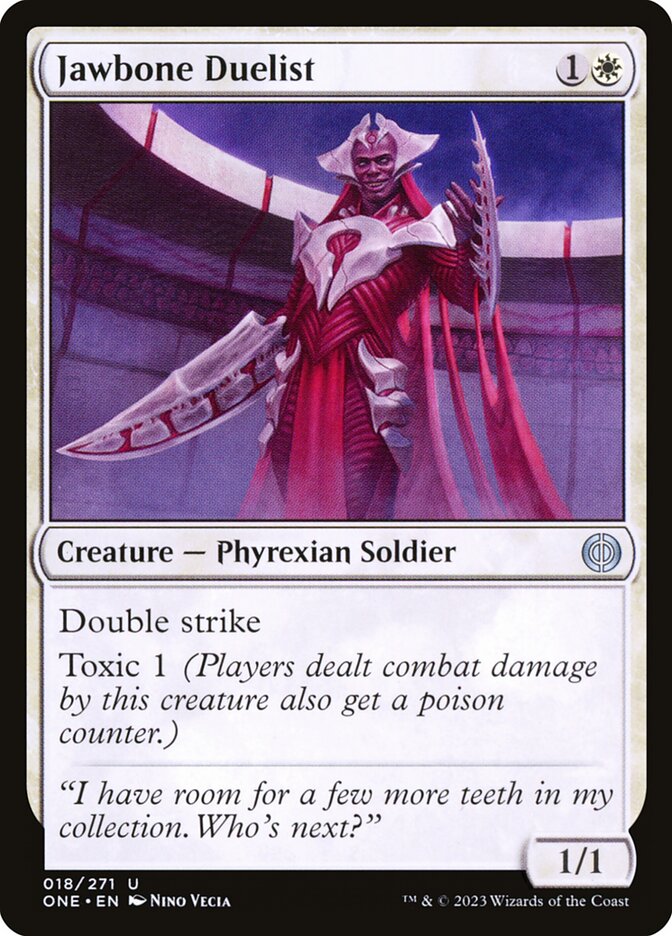
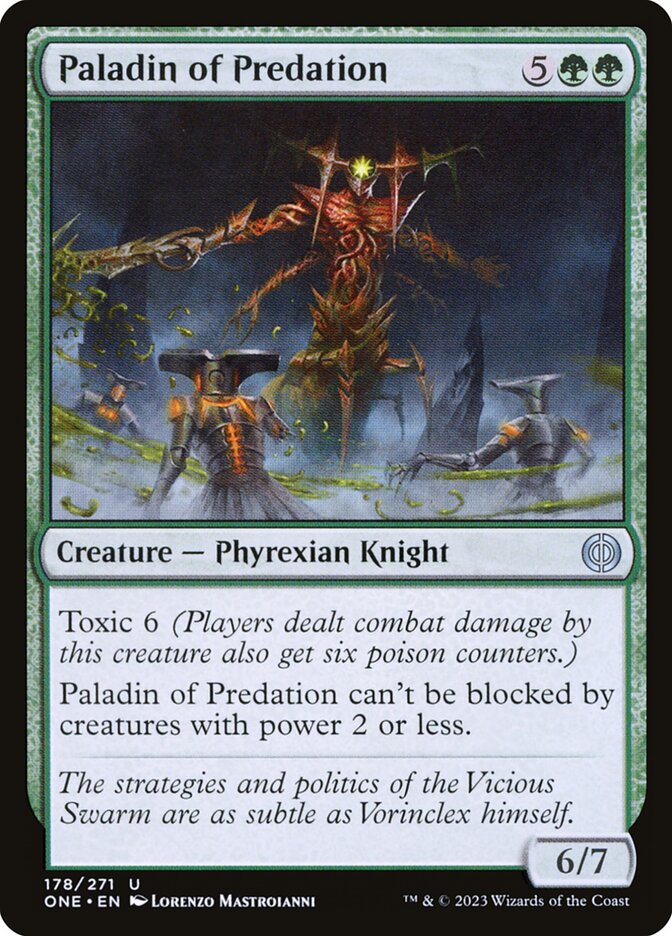
Toxic replaces Infect as the keyword that indicates a creature can spread poison. When a creature with Toxic N deals combat damage to an opponent, that opponent also receives N poison counters. So if you slap your opponent with a creature that has 3 power and Toxic 2, then you’d deal three damage to their life total and gift them with two poison counters. This means that you do not have to choose between winning through damage or winning through poison; in ONE both will always be an option. But if you’d like to focus on poisoning your opponent out, use cards such as Jawbone Duelist whose Double Strike effectively allows it to drop two poison counters per turn; or ramp up to Paladin of Predation with its incredible toxicity.
Toxic is principally found in White, Black, and Green. There are a few cards related to Toxic in Blue.
Corrupted

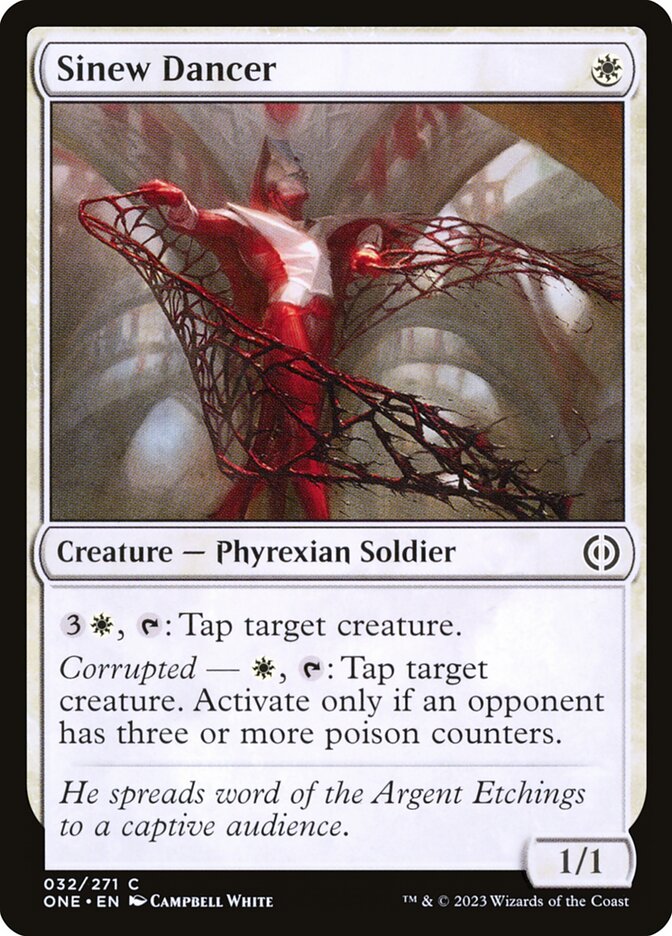
Winning the game by giving your opponent ten poison counters can be a daunting task. Fortunately One has a less daunting (although less fatal) threshold: if you give your opponent three poison counters, you activate Corrupted. Doing so activates a wide variety of benefits on a host of cards: Bonepicker Skirge gains two powerful keywords, while Sinew Dancer receives a cost reduction to its activated ability.
Cards with Corrupted are mostly found in Black and White, although a couple can be found in Blue and Green.
Oil Counters
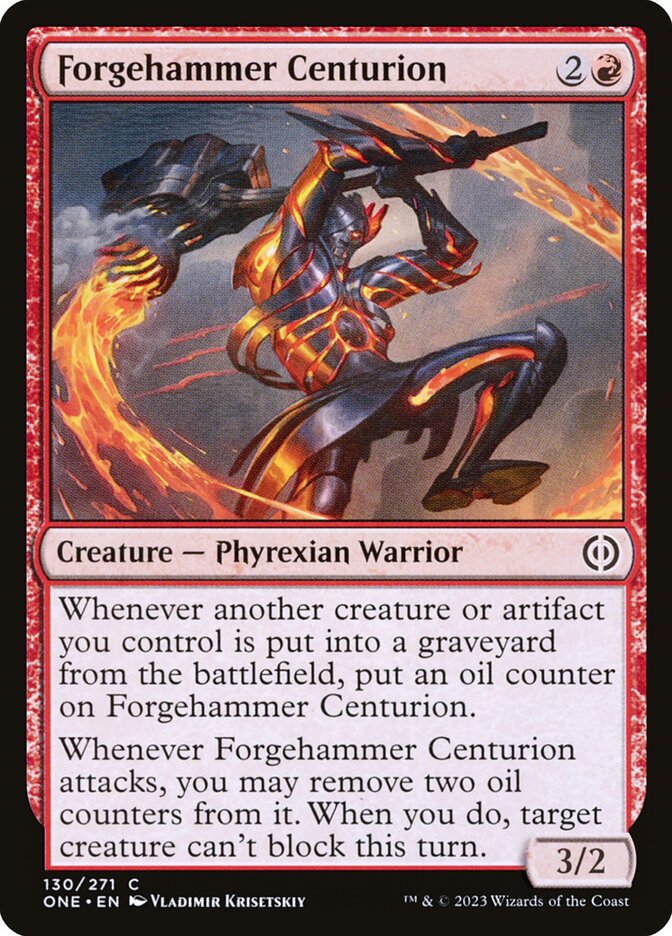

Oil counters are a new resource with a vast number of applications on different cards. Lattice-Blade Mantis starts with two oil counters that can be judiciously spent as a buff. On the other hand, Forgehammer Centurion must earn its oil counters before using them for its powerful ability.
All five colors have cards that accumulate oil counters; however the majority of them are in Blue, Red, and Green.
Proliferate
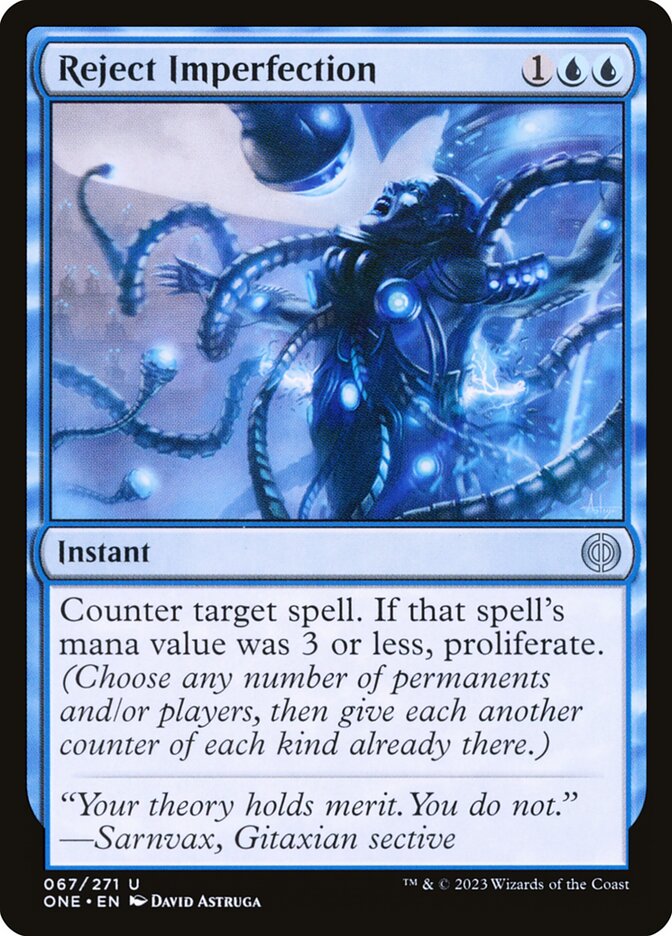
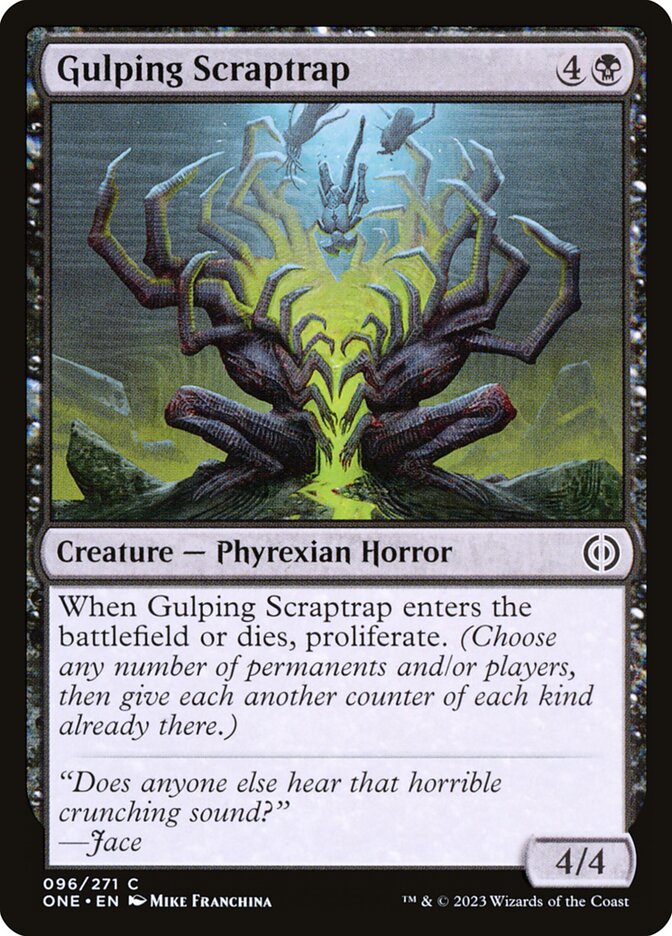
Proliferate is the beloved mechanic for counter lovers across all of Magic. When Proliferate triggers, the controller of the effect gets to select any number of permanents and players with counters; and increase the number of counters by one. This means you can increase oil counters on your permanents while leaving your opponent’s oil counters alone; and increase the poison count on your opponent while letting yours remain the same. What kind of cards have Proliferate? All kinds! Reject Imperfection is a Blue counterspell that brings Proliferate along for the ride, while Gulping Scraptrap is a five drop creature that Proliferates twice during its lifecycle.
Most Proliferate cards are in Blue, Black, and Green; there are also a few in Red.
For Mirrodin!

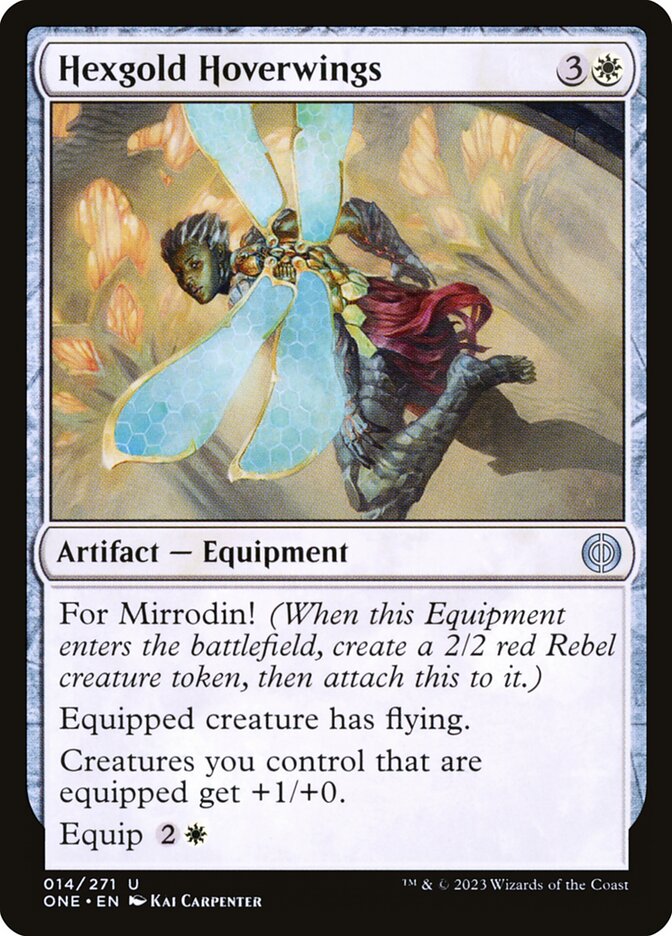
Oh yeah, there are still some natives of Mirrodin vainly struggling against the inevitable. When an Equipment with For Mirrodin! enters the battlefield, it creates a 2/2 Red Rebel token and attaches itself to that token. This means that Barbed Batterfist is effectively a three mana 3/1, and Hexgold Hoverwings is a four mana 3/2 with flying. Those are reasonable rates - but what puts these Equipment over the top is that their buffs can be transferred to any other creature.
Almost all For Mirrodin! Equipment are in Red and White. Blue and Green each have a single one.
Planeswalkers
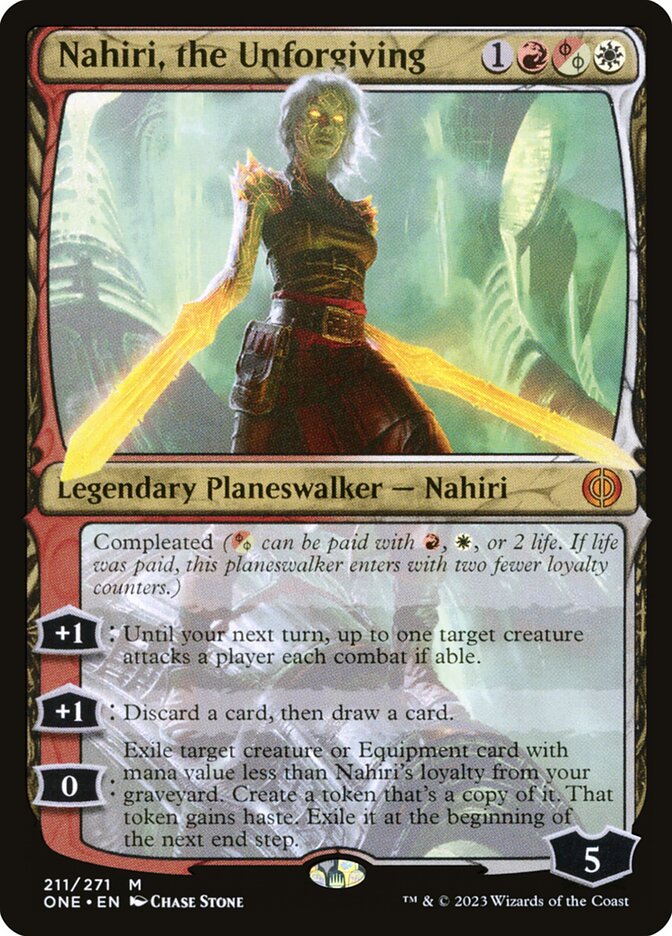
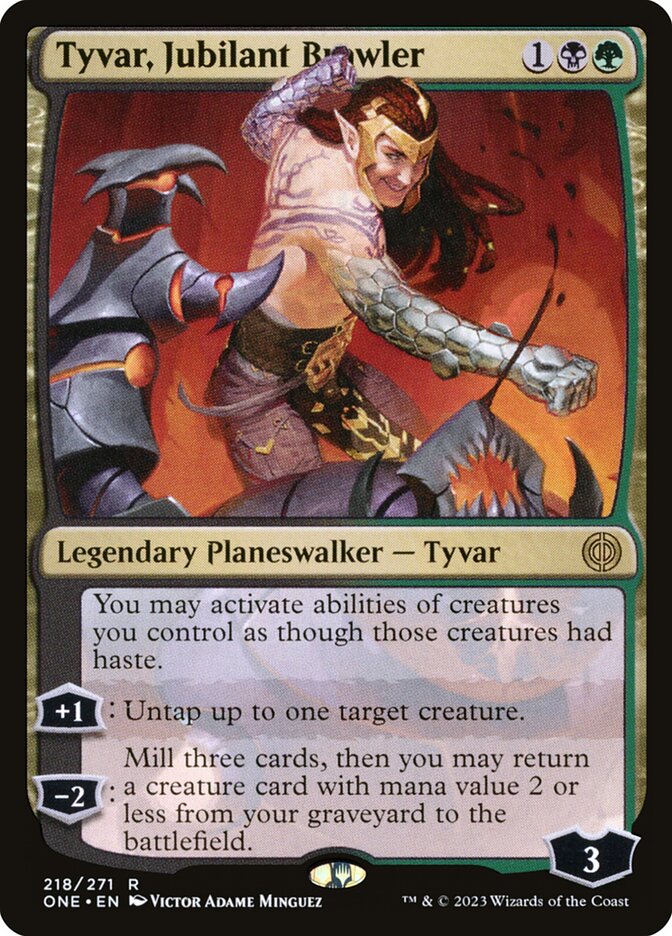
Normally I ignore mechanics and themes that are only found at Rare or Mythic, and in ONE planeswalkers are only found at Rare or Mythic. Still, there are ten of them and there’ll likely be at least one floating around any given draft pod. So be aware that they exist; be aware that half of them have the Compleated keyword and can be cast on the cheap with Phyrexian mana; and be aware that they’re really powerful with Proliferate effects.
Archetypes
Let’s delve into the archetypes of One.
White/Blue: Artifacts
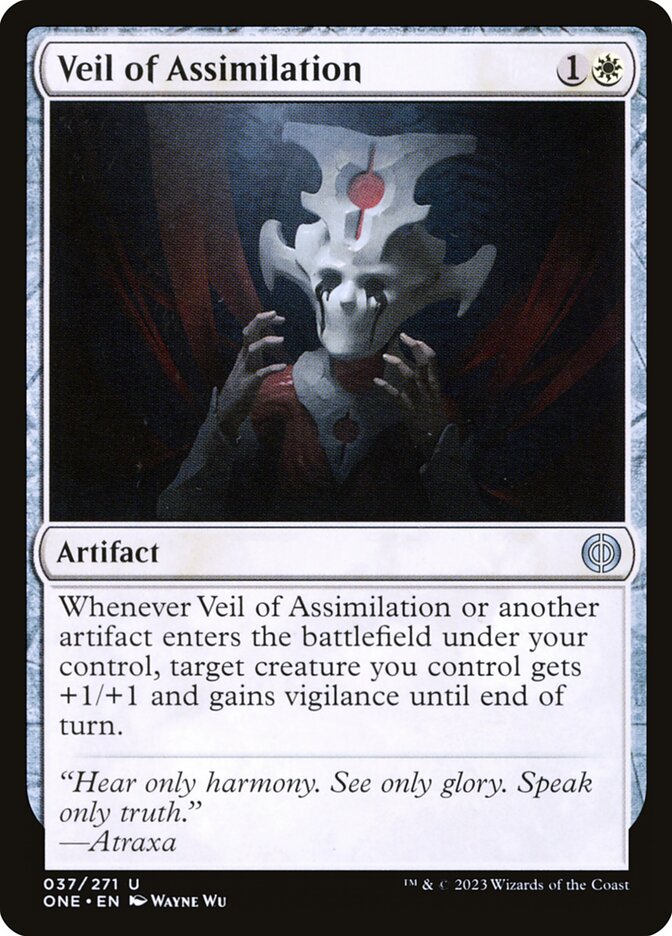
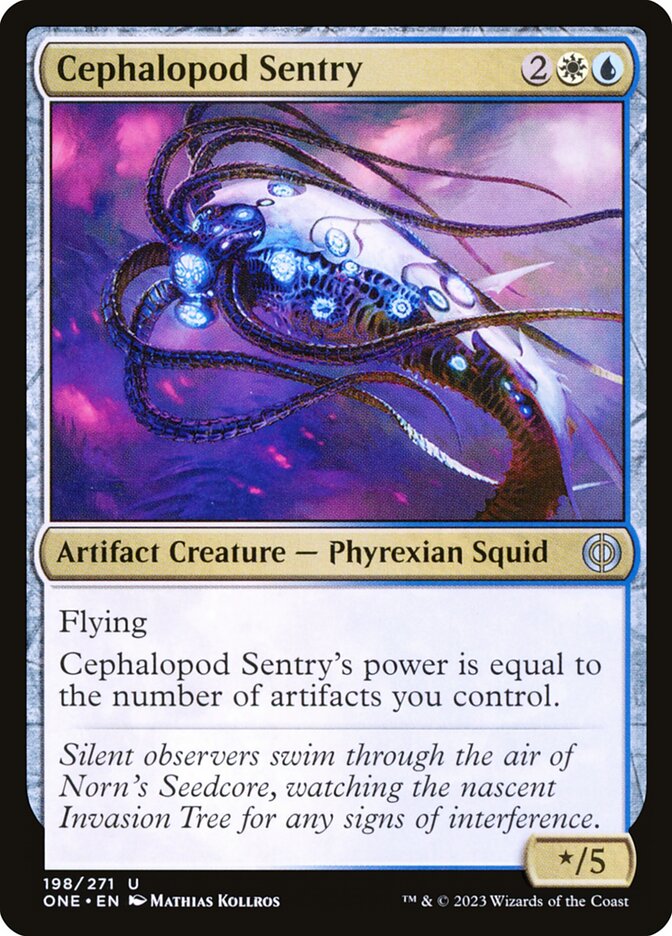

Into the midst of all the various counters and Equipment shenanigans comes… a pretty basic archetype that simply cares about artifacts. Cephalod Sentinel will quickly become a terminal threat as your artifact count increases, while Veil of Assimilation and Eye of Malcator have aggressive “artifactfall” type effects. But where can you find artifacts in a non-artifact set? Well, ONE does contain a surprising number of incidental artifacts: random creatures, Equipment, and the 1/1 Phyrexian Mite token creatures that White produces in abundance. The other advantage of this archetype is that it doesn’t focus on Poison or oil counter synergies. That means it has the opportunity to find the open mechanic - and take advantage of it in full.
White/Black: Corrupted Midrange
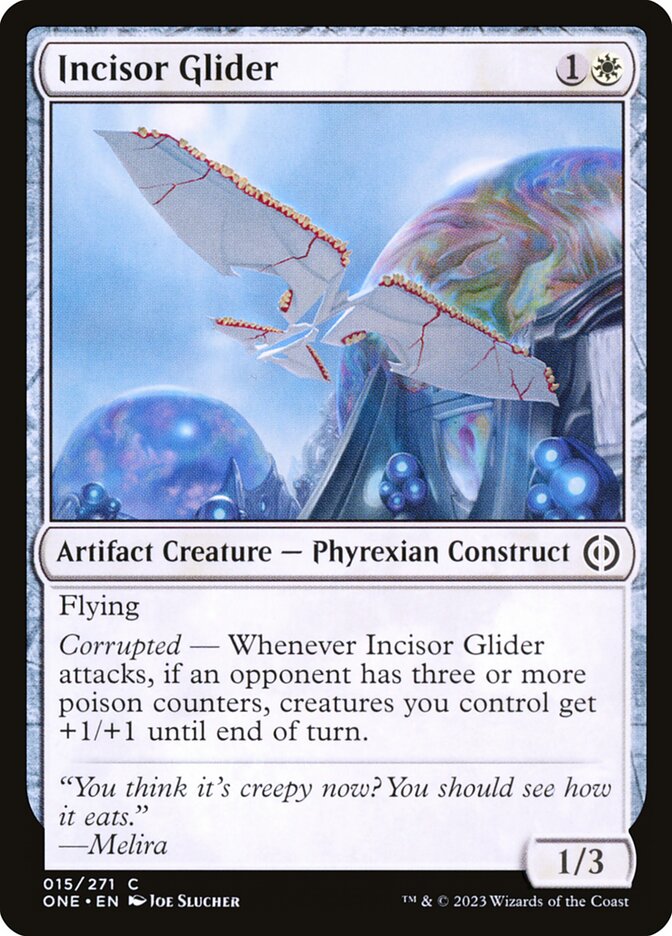
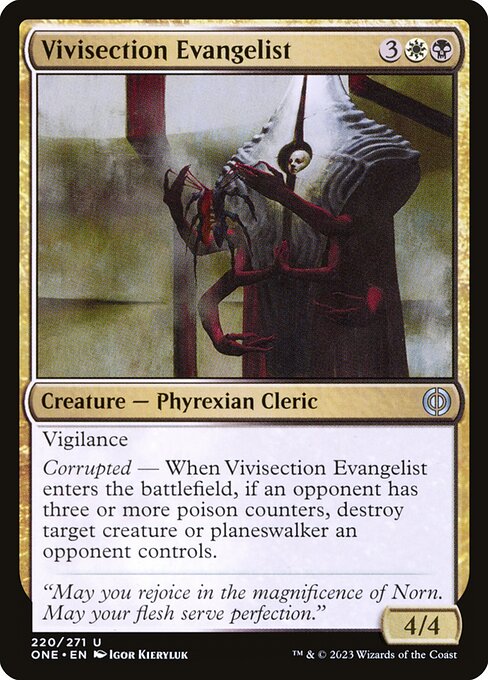
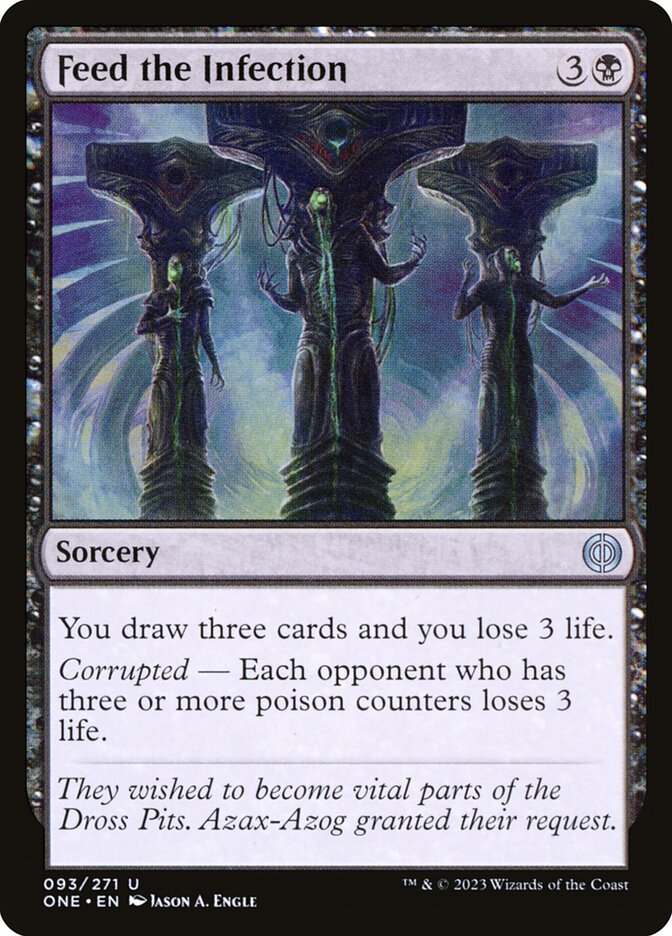
As we’ll see below, other poison archetypes heavily feature creatures with Toxic. Those archetypes aim to achieve victory by spreading ten poison counters on an opponent. White/Black is less… greedy, content with the much smaller poison number of three. Doing so unlocks powerful Corrupted effects, such as the killing ability of Vivisection Evangelist, or the mass pump provided by Incisor Glider that allows your creatures to overrun the board. Alternatively, use Feed the Infection to draw much-needed cards while chipping away at everyone’s life total - and maybe just killing your opponent outright.
Blue/Black: Poison Control



A small evasive threat that has Toxic and an ability triggered by Proliferate adds up to… what? It’s hard to say, unless you also know that Voidwing Hybrid is the Blue/Black signpost uncommon. This color pair is often a grindy control archetype with a painfully slow win condition, and so it is here. Get a Poison counter or two on an opponent with Voidwing Hybrid - and if your opponent has defenses against flyers, just cast Vraska’s Fall to start the poison train while keeping their board in check. Once that’s done, all you have to do is Proliferate your way to victory. Experimental Augury is especially good for this: not only does it allow you to dig for whatever card you need, it’s also an instant that allows you to keep your mana up for interaction.
Blue/Red: Oil Counters / Non-Creature Spells
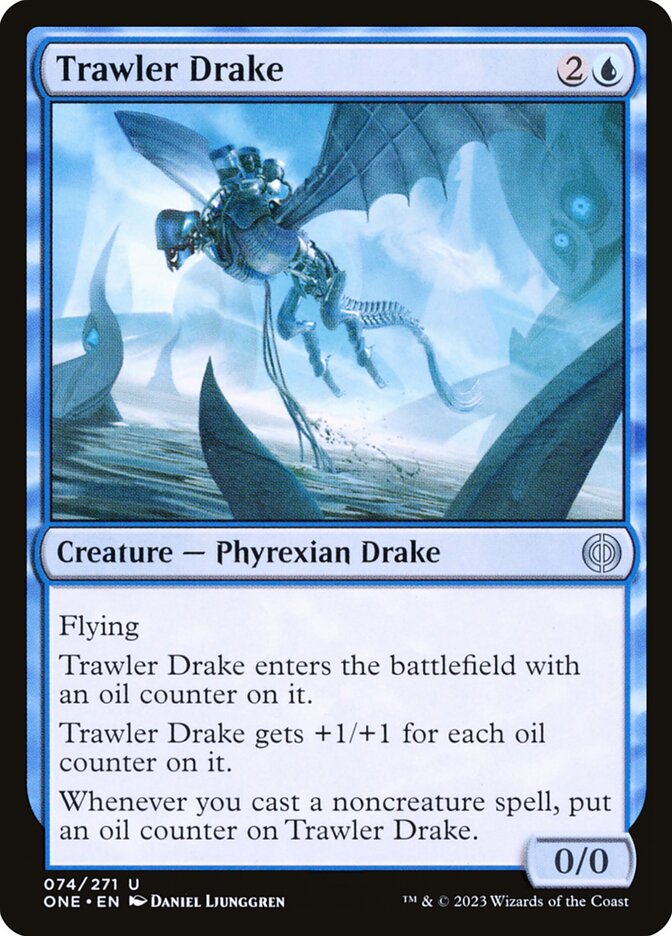
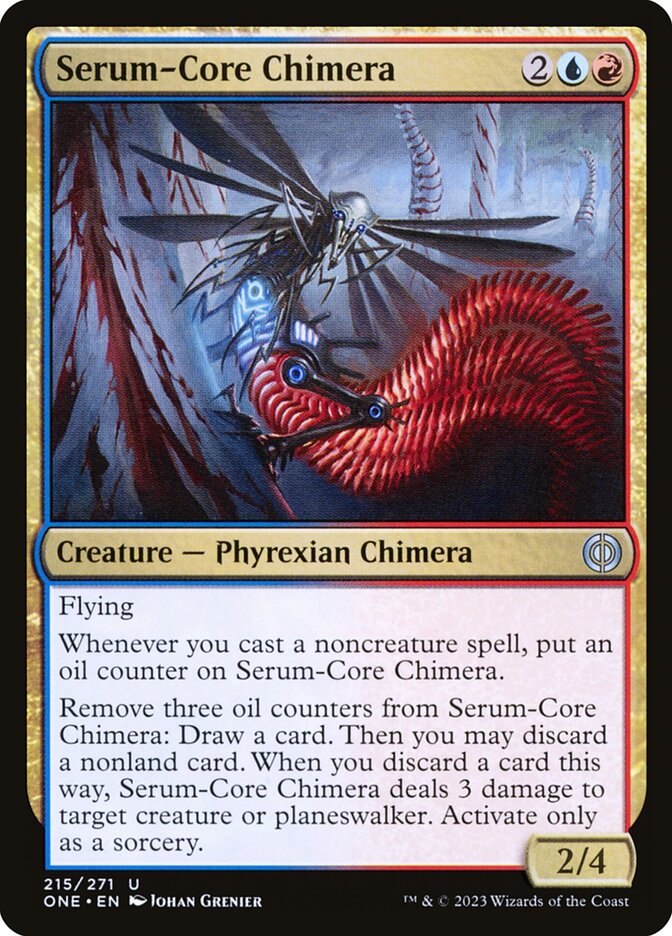
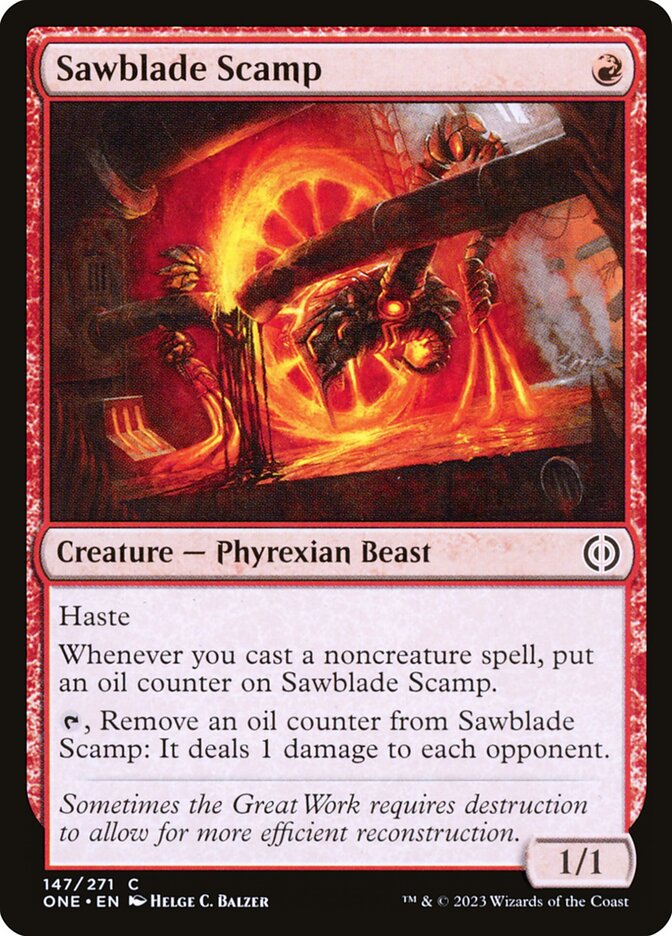
Limited non-creature spell archetypes can be fast or slow, and Serum Core Chimera tells us what the speed of this archetype is in ONE. It has a very powerful ability with its combination of loot + bolt, but building up the three oil counters needed is something that will take time. Trawler Drake and Sawblade Scamp are two other creatures that build up strength through non-creature spells and oil counters. These three creatures work especially well with non-creature spells that have an incidental Proliferate effect, effectively increasing your oil counters by two. And if you’re trying to strike the right balance between creatures and non-creatures, just remember that the copious number of For Mirrodin! Equipment allows you to cheat by counting as both.
Black/Red: Oil Counters Sacrifice / Aggro
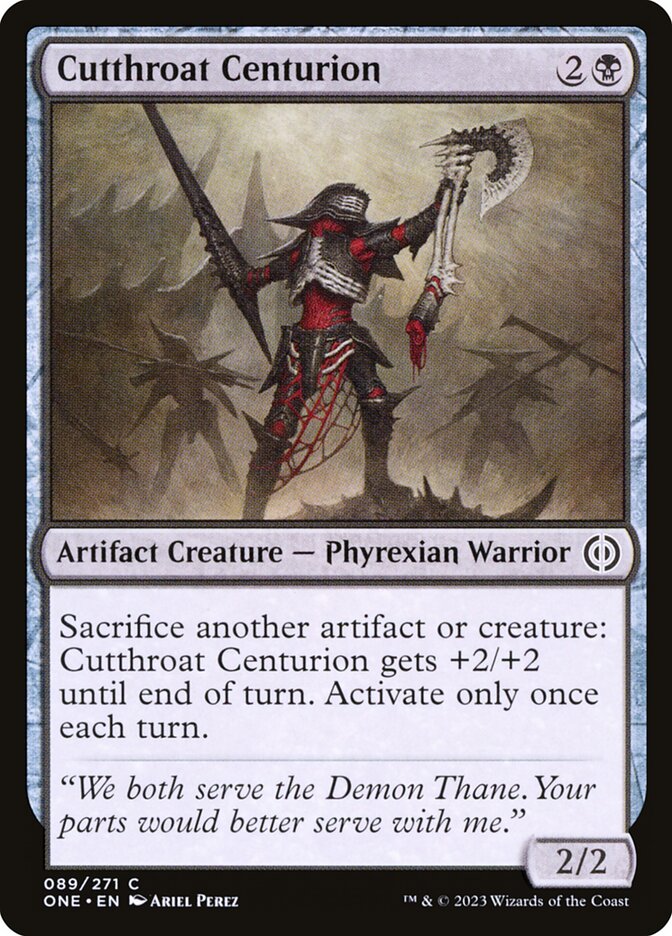
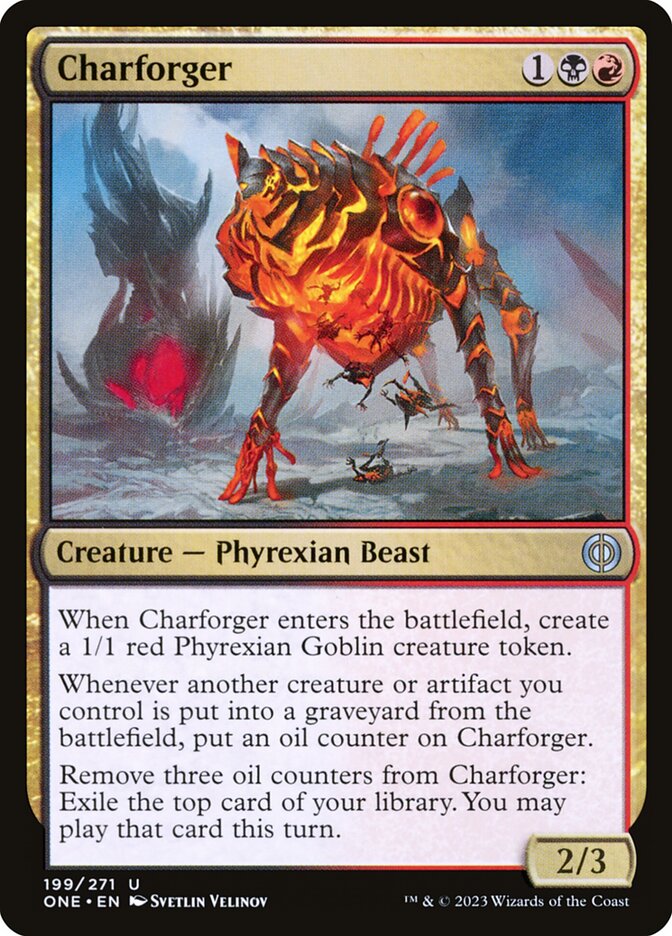

There’s a subset of cards that build up oil counters whenever a creature or artifact you control goes into their graveyard, and they’re all Black or Red. Exuberant Fuseling may seem laughable, but get a few oil counters on it and you’ll be the one laughing your way to victory. But how can you guarantee that your creatures will die? Well, the good news is that it’ll happen naturally as you dump out your aggressive threats. However, if you’d like to expedite the process, there are a few cards - such as Cutthroat Centurion - that serve as sacrifice outlets. Tying all of these threads together is the signpost uncommon: Charforger, a creature that creates sacrifice fodder while also possessing an ability to take advantage of it.
Black/Green: Poison Midrange
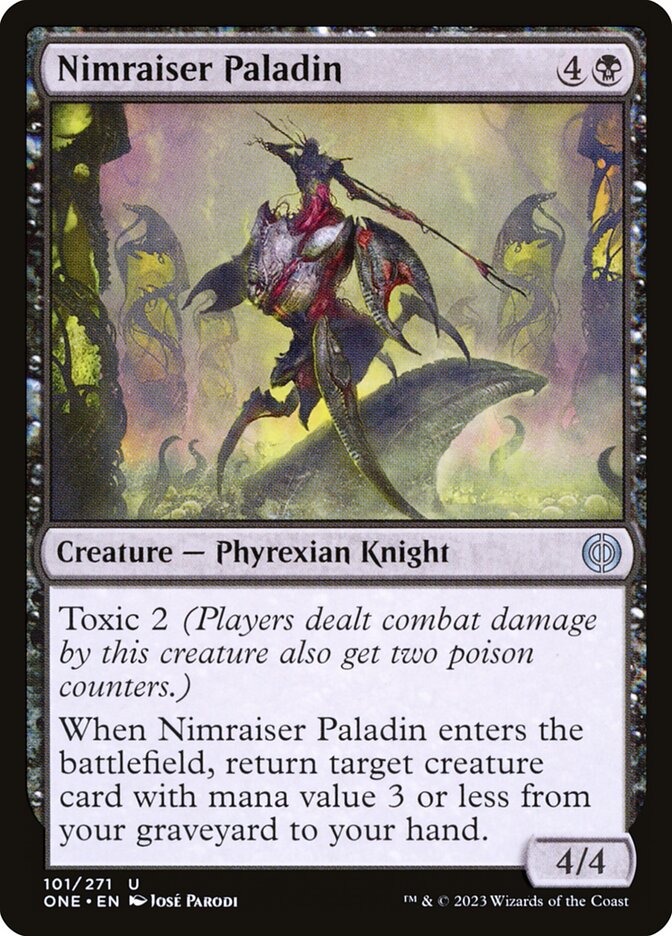
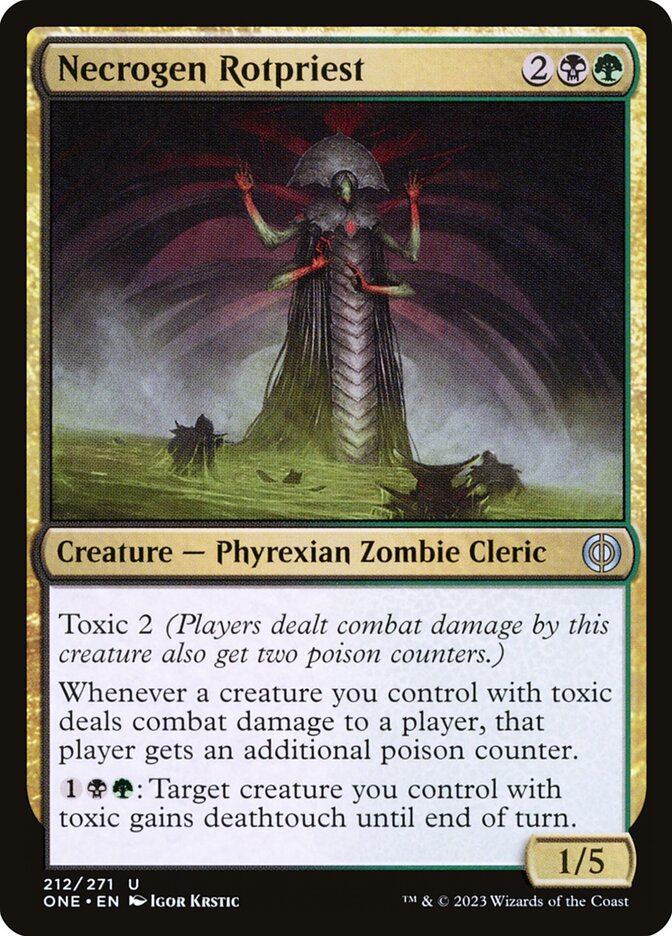

What does a midrange poison deck look like? It has cheap Toxic creatures with which it hopes to chip in a Poison or two in the early game; but it's true power comes to the fore once it reaches 4+ lands. Then you can play creatures such as Nimraiser Paladin to retrieve early casualties, or Tyrranax Atrocity to simply surprise your opponent with a sudden infusion of poison. The cherry on top of this questionable cake is Necrogen Rotpriest. This signpost uncommon not only increases the rate at which an opponent accumulates poison counters; it can give your Toxic creatures deathtouch, forcing your opponent to make some very tragic decisions in order to survive.
Red/White: Equipment Aggro
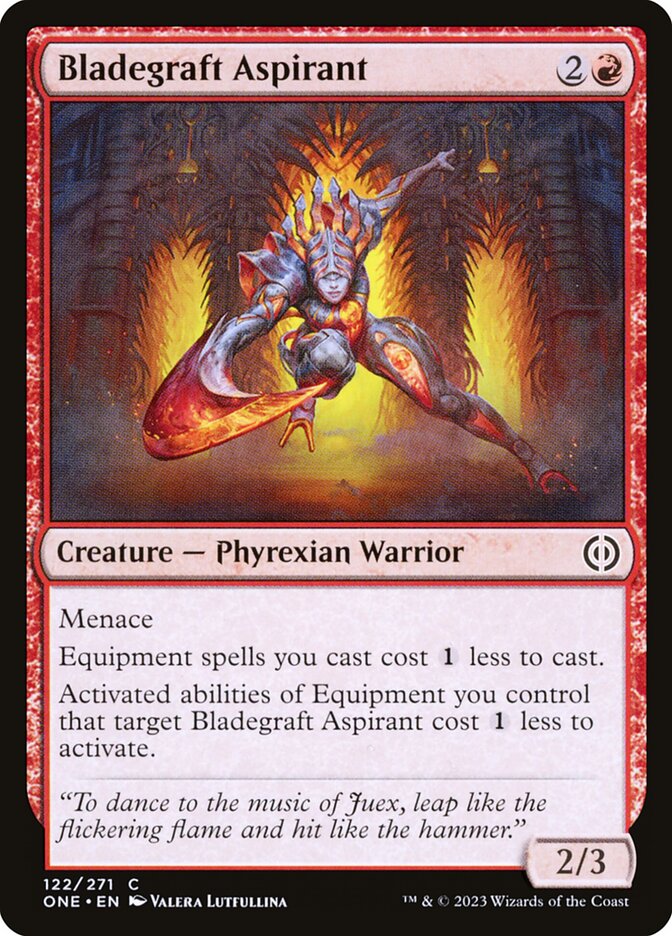
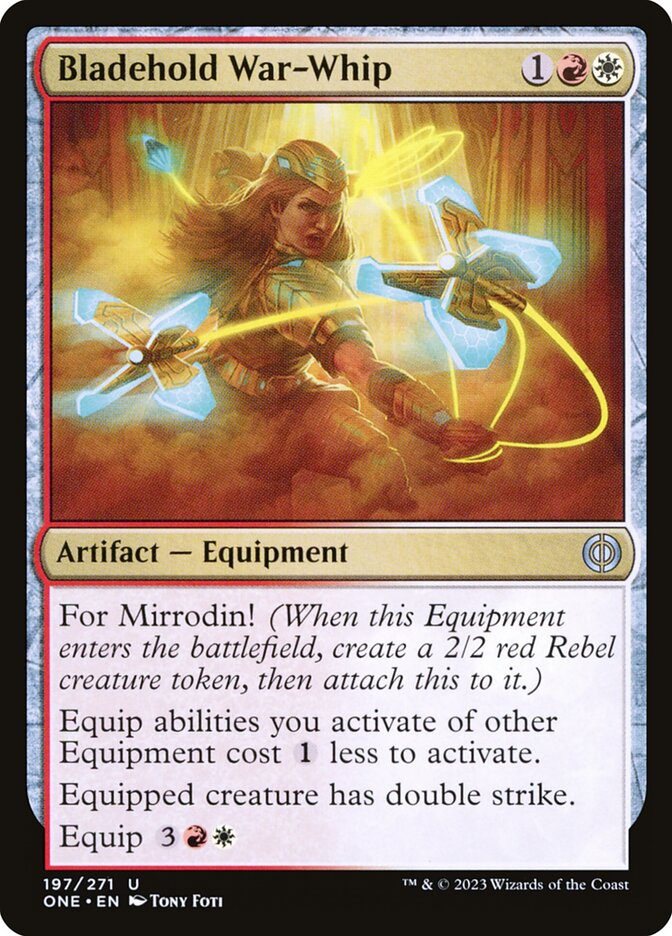
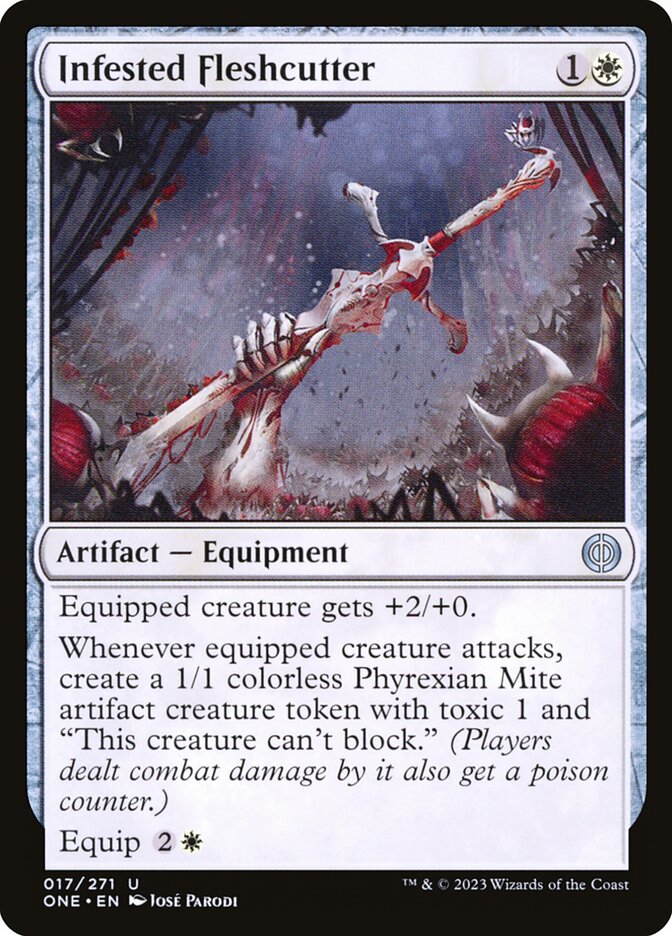
A three mana Equipment feels like an odd choice as the signpost uncommon for an aggressive archetype. But the For Mirrodin! keyword means that Bladehold War-Whip is actually a three mana 2/2 with double strike, *plus* the additional upside of being able to move that double strike around. Doing so allows the weakest of your threats to turn into nightmares for your opponent to deal with. Red/White is supposedly the color pair of the Mirran resistance, but there are plenty of Phyrexian cards that would love to join into the fun. Infested Fleshcutter is an Equipment without For Mirrodin!, but its ability to generate a constant flow of creatures is ideal for a strategy that relies on having creatures to constantly equip. Equip costs are not free however, and that’s where Bladegraft Aspirant comes into play: an evasive creature that’s ready to grab all your loose Equipment and go to town.
Red/Green: Oil Counter Chonkers
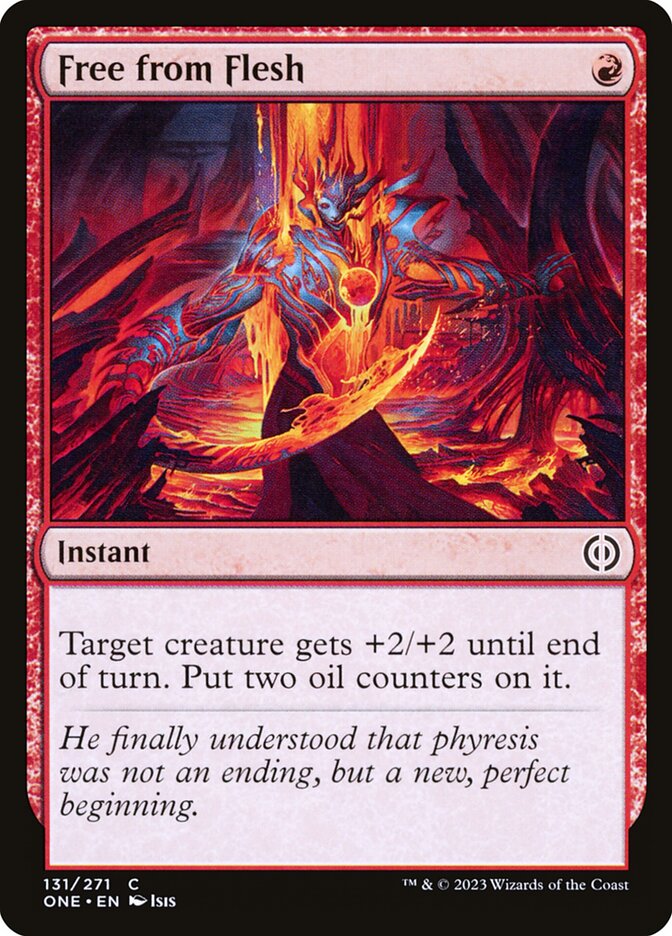
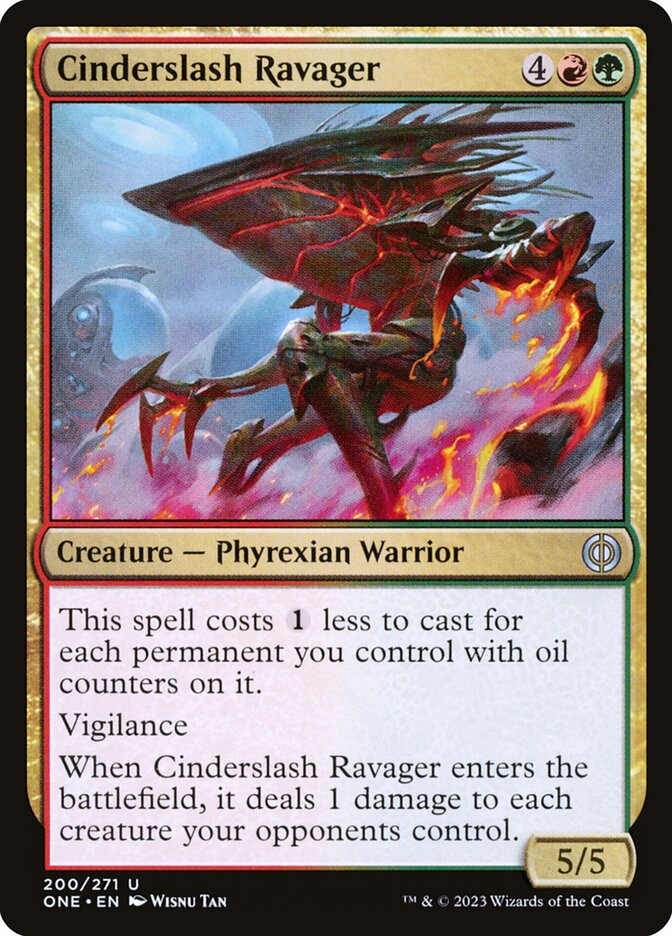
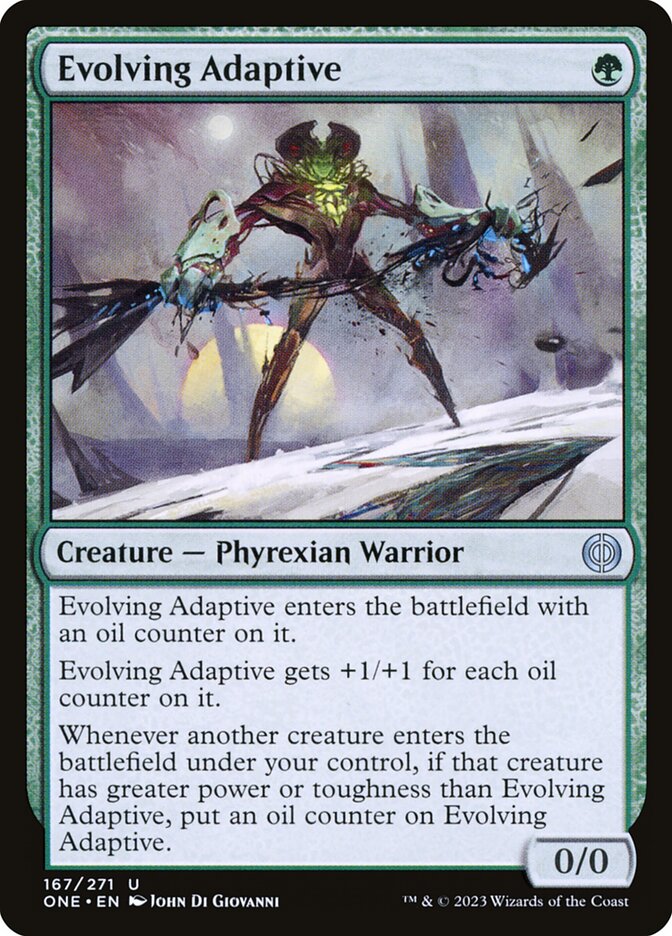
There’s a lot of subtlety to the interplay between Poison and oil counters and Proliferate. But maybe you’d rather just beat your opponent’s face in. If so, welcome to Red/Green, the archetype that wants to do just that. Sure, there’s an oil counter subtheme to the archetype - but it’s not a difficult one to work with. Evolving Adaptive will accumulate oil counters naturally with each subsequent creature you play; Cinderslash Ravager becomes a severely undercosted threat under the right circumstances (that can also wipe away an opponent’s board of Mite tokens). I suppose there’s some ingenuity in using Free from Flesh on the right creature, but overall this archetype is pleasingly straightforward.
Green/White: Poison Aggro
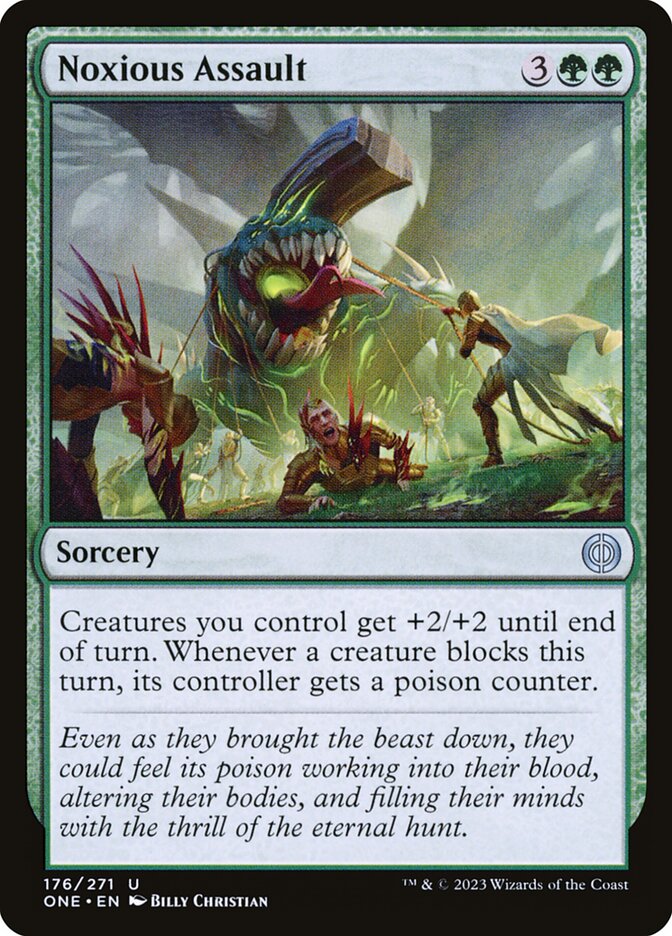
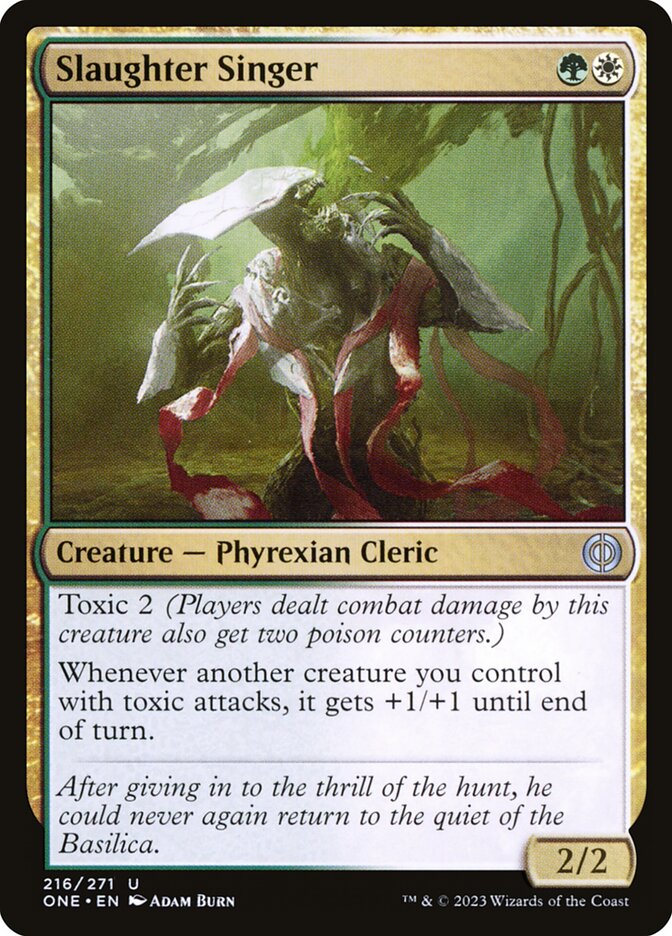

ONE has its share of slow, deliberate poison archetypes. Green/White is not one of those. Oh, this color pair loves its Toxic creatures, but it’s not interested in waiting around. Instead it wants you to attack and attack and attack some more, until the game ends due to damage or poison. Slaughter Singer is the poster child for this philosophy: a cheap creature with Toxic 2 that also buffs the power of all your other Toxic creatures. But what if your opponent clogs the ground? Flensing Raptor allows your landbound creatures to take to the skies. And once you’ve built up enough poison on your opponent, use Noxious Assault to end the game with one final furious onslaught.
Green/Blue: Poison Ramp
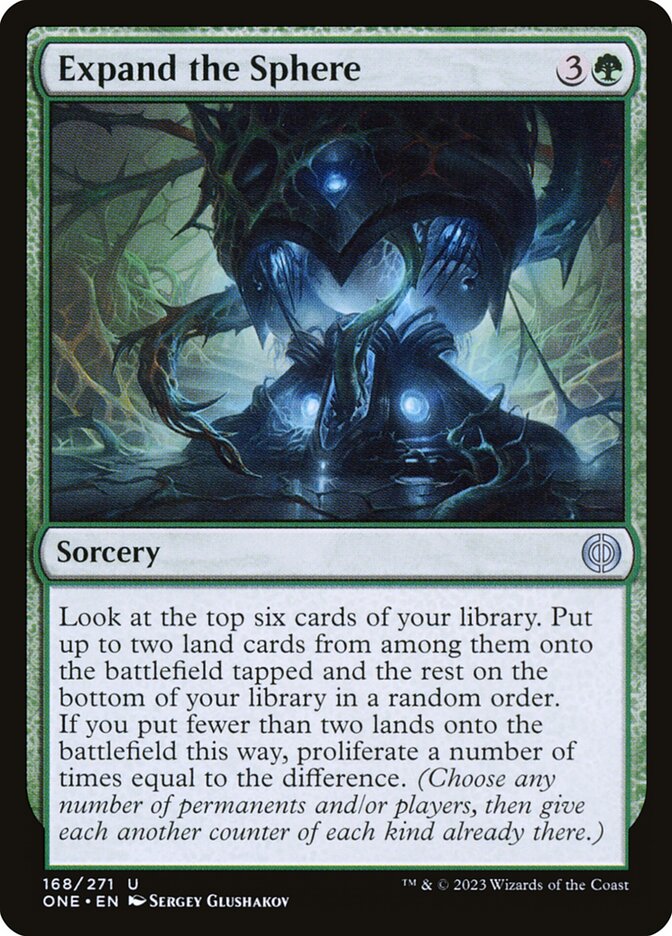
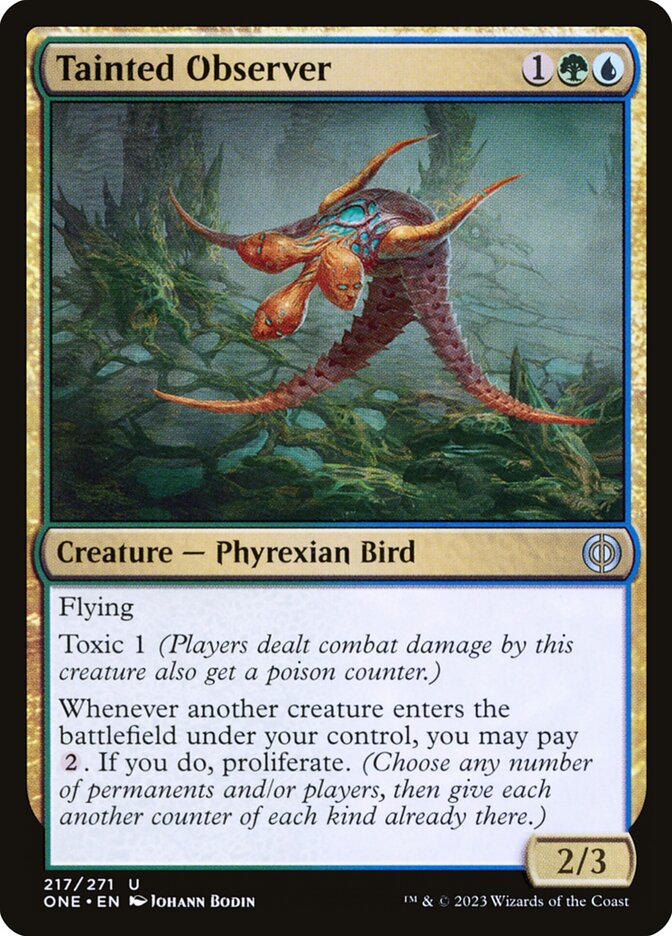
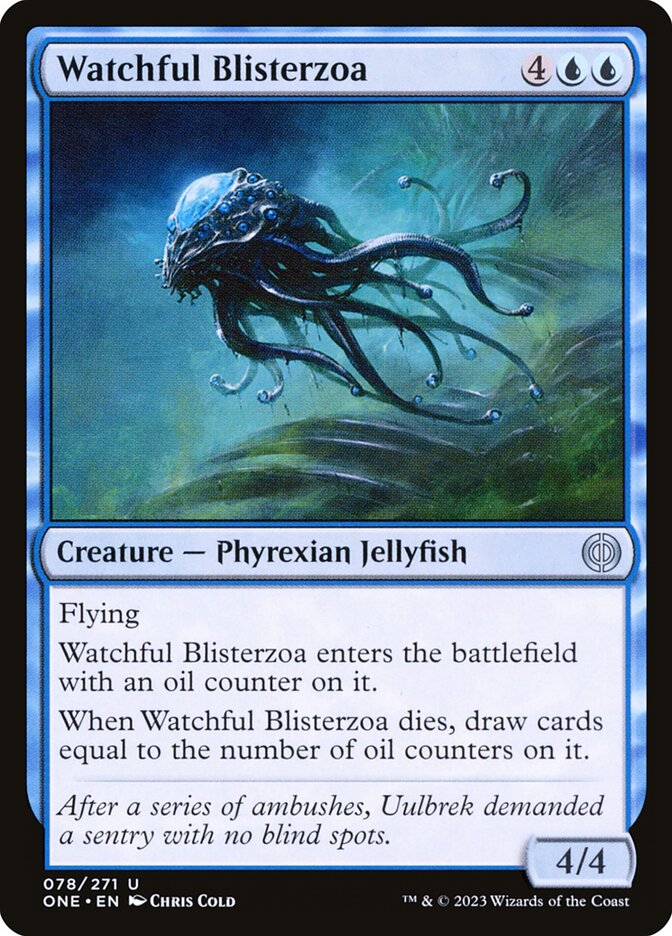
Both Green/Blue and Blue/Black have a signpost uncommon with evasion and a Proliferate related ability. So what’s the difference between the two archetypes? Well, Black is a more controlling color, and Green is… not. What does it have instead? Beefy creatures and ramp effects. Combine that with Blue and you get a slow creature-based deck that durdles along in the early game before falling into late game inevitability. Tainted Observer is an excellent uncommon for such a strategy, turning all of your creatures into Proliferate effects to poison your opponent or spread your oil counters. This flexibility is reflected in Expand the Sphere, a ramp spell that allows you to Proliferate instead if you no longer need the lands. And once you have your lands, cast Watchful Blisterzoa for a threat that either wins in the air - or draws you more cards when it dies so that you can try again.
Mana Fixing
Let me start out by saying that I thought Brothers’ War was going to be a strictly two-color Limited environment, and ended up being extremely surprised at how straightforward it was to splash multiple colors - life and Magic players find a way, I guess. All of this is a prelude to saying that I don’t think the mana fixing in ONE is great… but if you want to splash for bombs or removal, there’ll be ways to do so. It’ll just be harder to do so than in more multicolor focused sets.
Here’s the colorless fixing at common and uncommon:

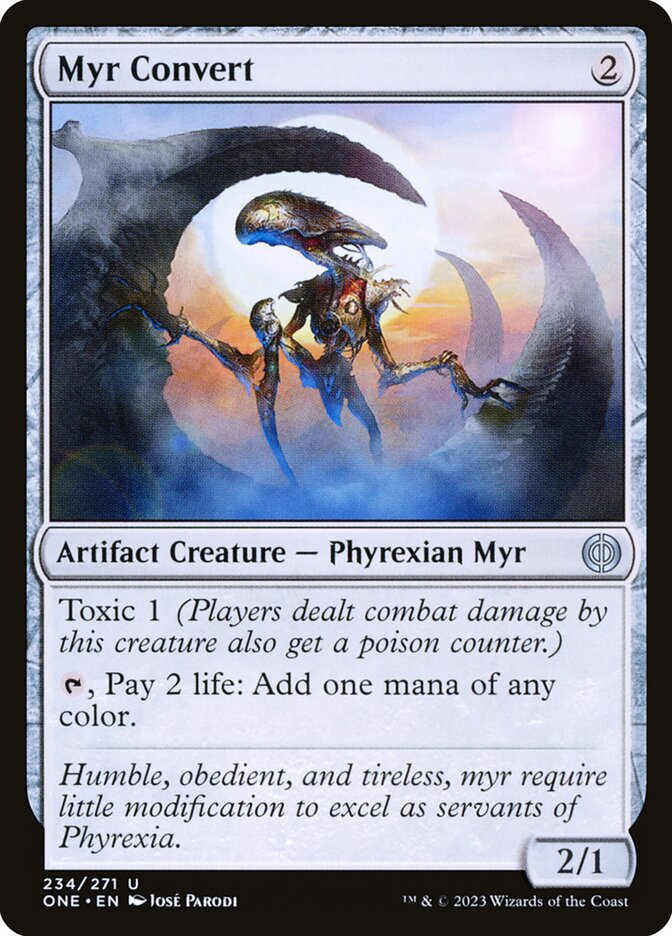


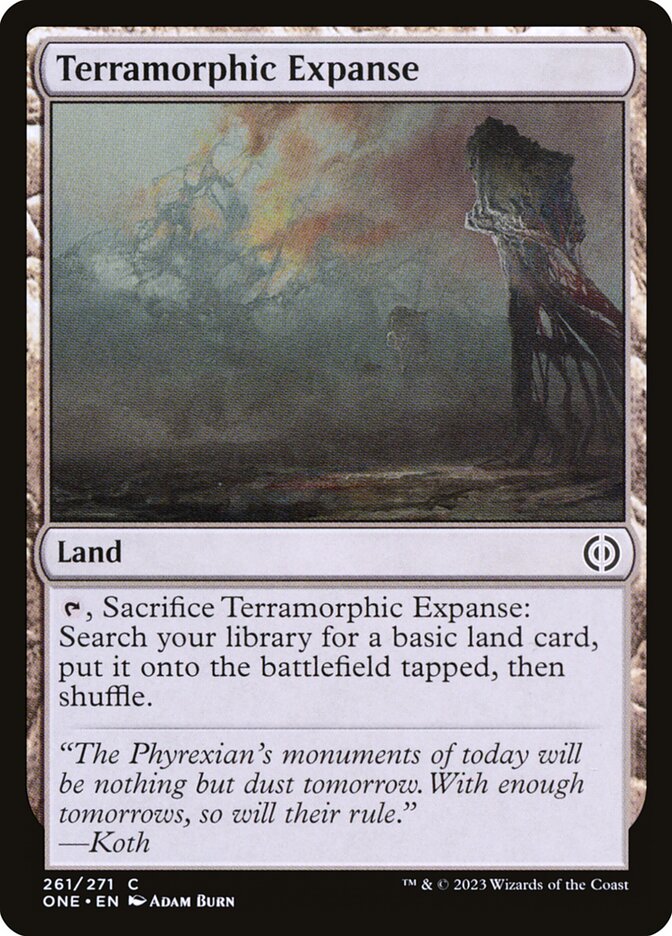
It’s not free, but it’s not terrible either. If you want to splash, you should be able to find a card or two that lets you do so.
Naturally, Green has a few additional options. They’re both quite good, and will likely be drafted high by any Green deck.

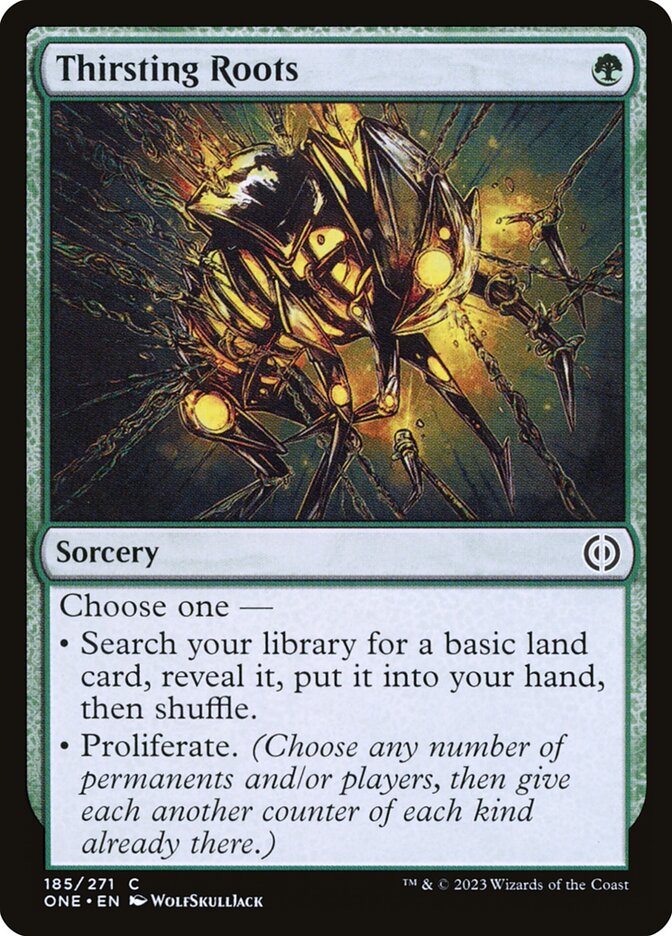
Key Commons and Uncommons
White
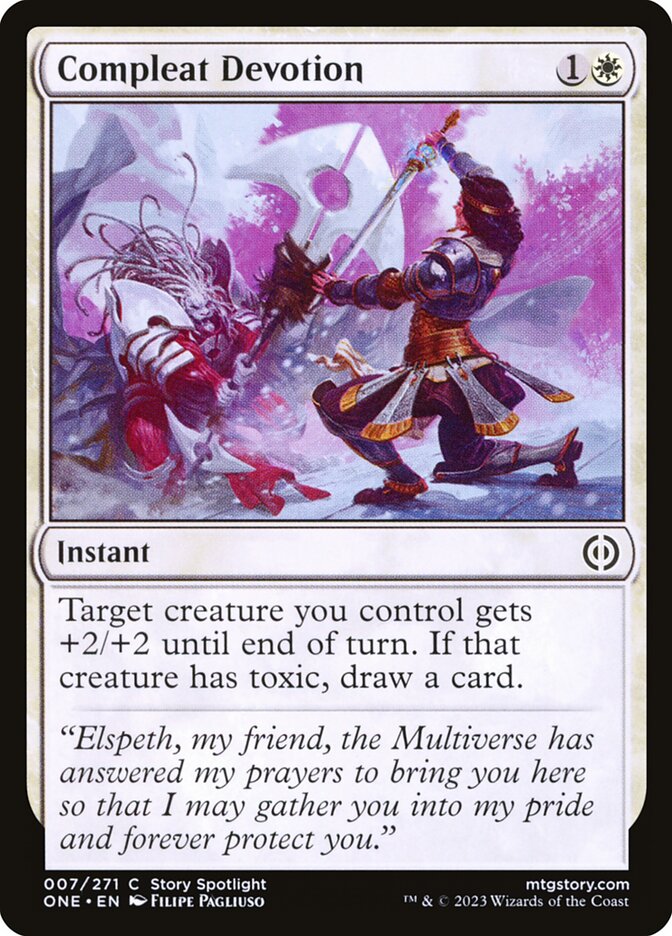

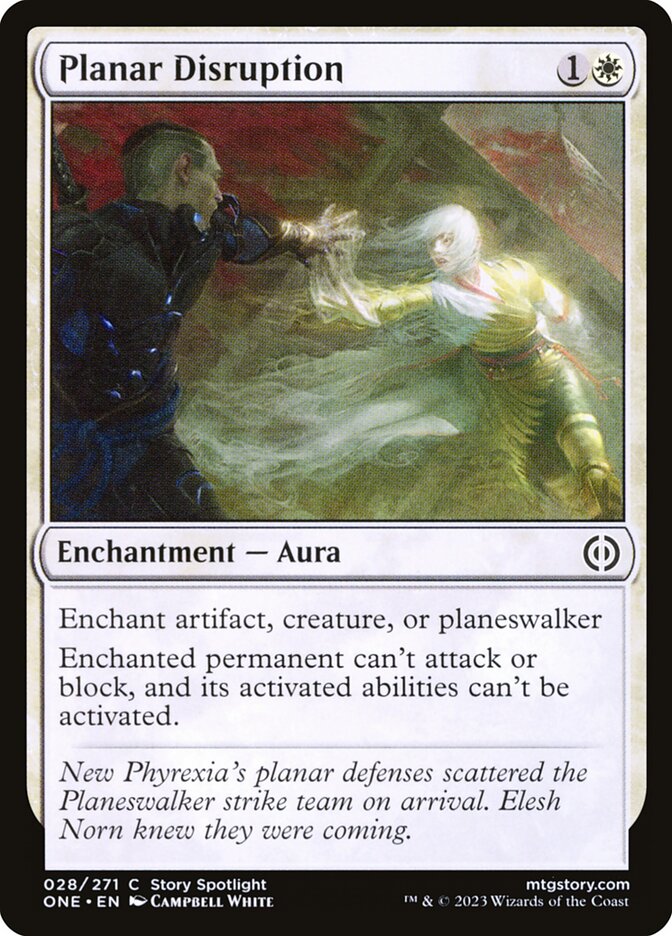
- Compleat Devotion: If you’re playing an aggressive Toxic deck, then this trick will win you combat while replacing itself.
- Ossification: Two mana to exile any creature or planeswalker is… yeah. It’s good.
- Planar Disruption: Two mana to neuter any creature or planeswalker or artifact is… well, it’s slightly worse than Ossification because the targeted permanent remains on the battlefield. That means it can still be sacrificed, and its static abilities stay on. This is great removal nevertheless.
Blue

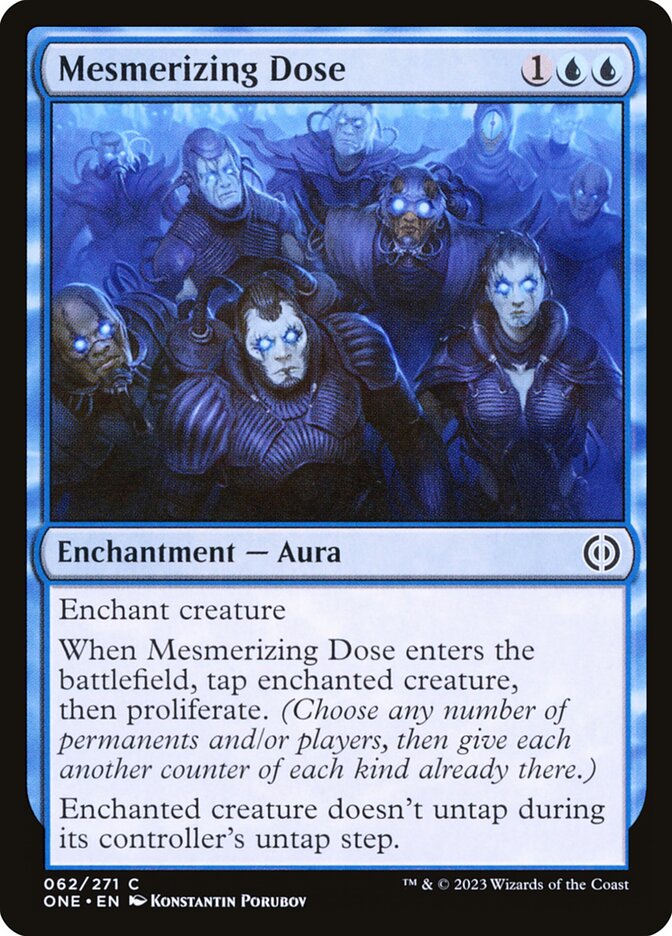

- Distorted Curiosity: Draw-two spells for three mana are quite good in slower Limited decks, and Blue’s poison/Proliferate strategy looks to be just that. Also, surprise! This draw-two spell actually costs one mana.
- Mesmerizing Dose: This is Blue’s typical tap-and-do-not-untap Aura, except the addition of Proliferate to its effect makes it enormously appealing.
- Serum Snare: This is Blue’s typical instant bounce effect, except the addition of Proliferate to its effect makes it enormously appealing.
Black


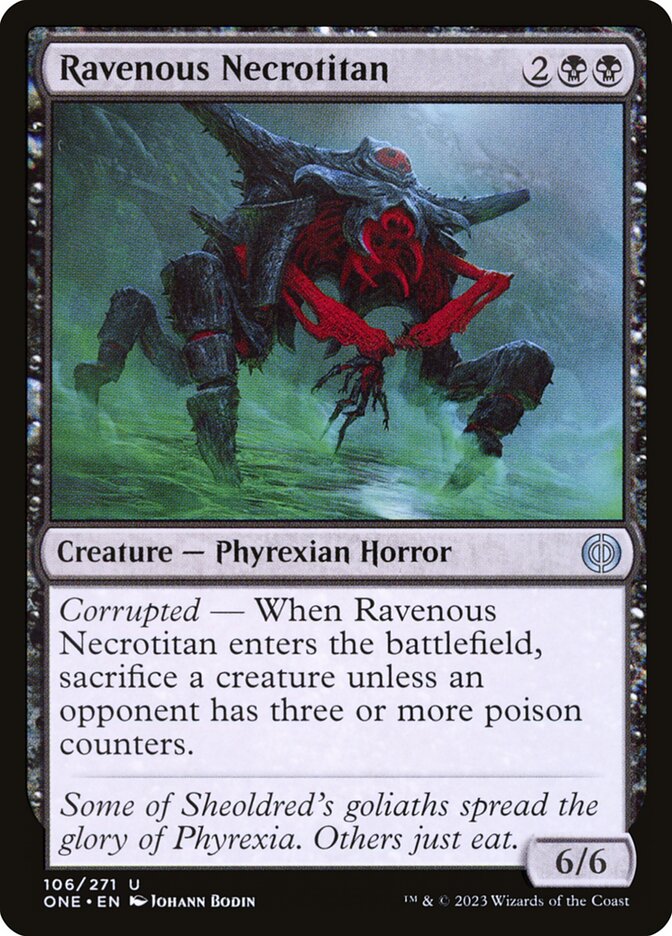
- Anoint with Affliction: Well, this two mana removal spell that exiles at instant speed just scales beautifully, doesn’t it.
- Drown in Ichor: It’s not instant speed, so the -4/-4 effect can’t be used as a combat trick. But it’s still enough to get most creatures out of the way, and Proliferate is just a staggeringly great bonus.
- Ravenous Necrotitan: In one kind of deck, the sacrifice drawback is actually an upside. In another kind of deck, you’ll never have to sacrifice a creature. Either way, it’s a 6/6 for four mana.
Red
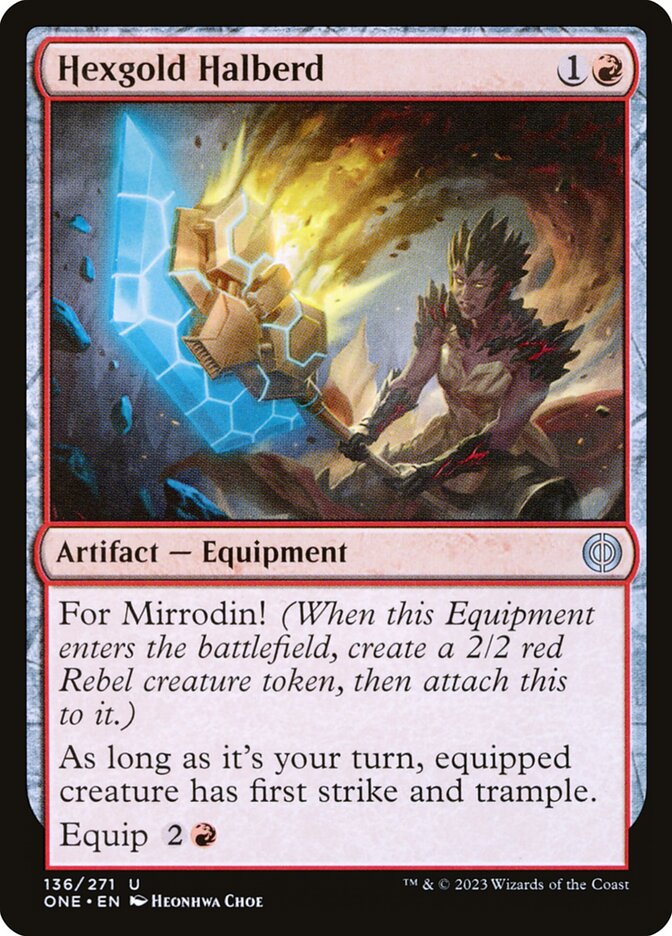
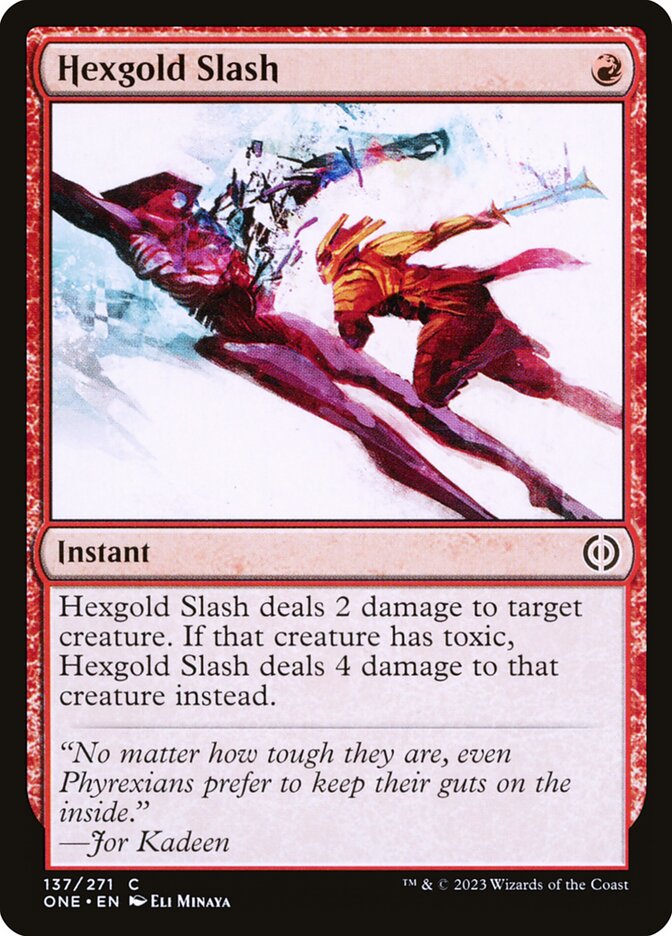
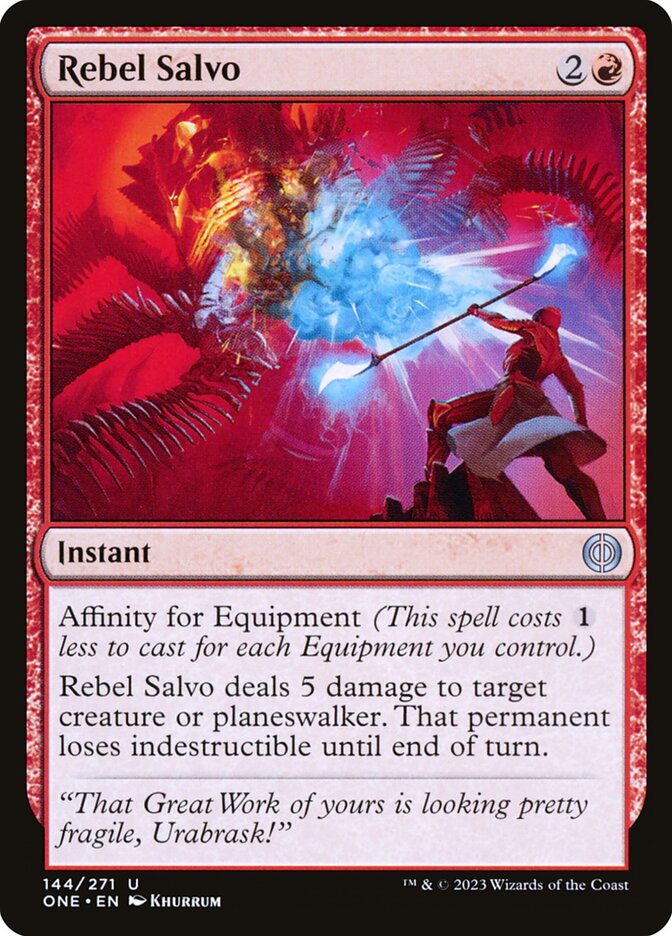
- Hexgold Halberd: A 2/2 for two mana with first strike and trample is already great (even if the first strike only applies on your turn). Now make those keywords transferrable, and you get something even better.
- Hexgold Slash: This one mana instant will kill a lot of things you want to kill.
- Rebel Salvo: I’d gladly pay three mana to do five damage at instant speed. Doing so for two - or one! - mana just feels like cheating.
Green
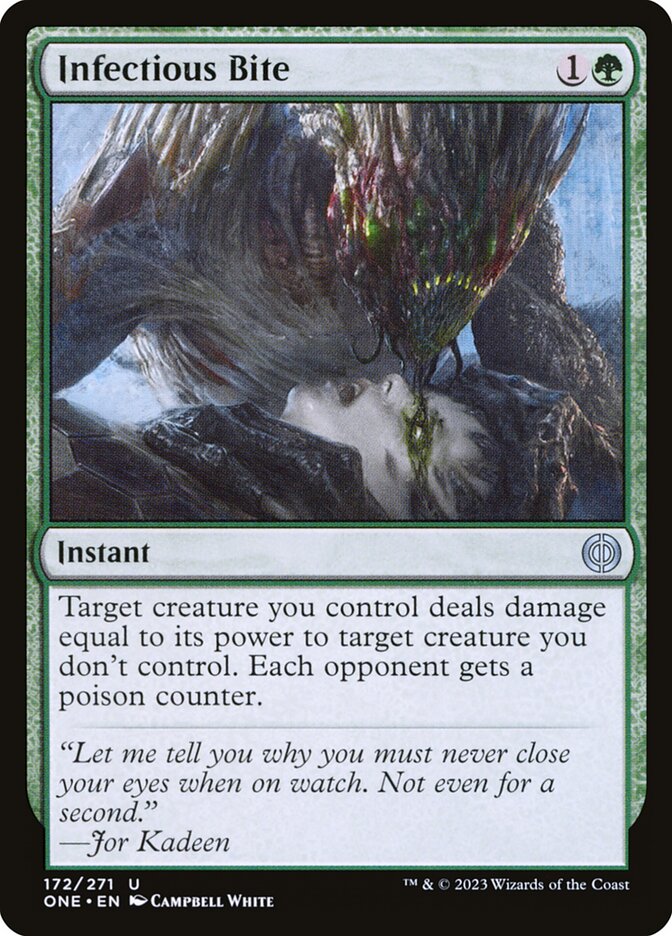
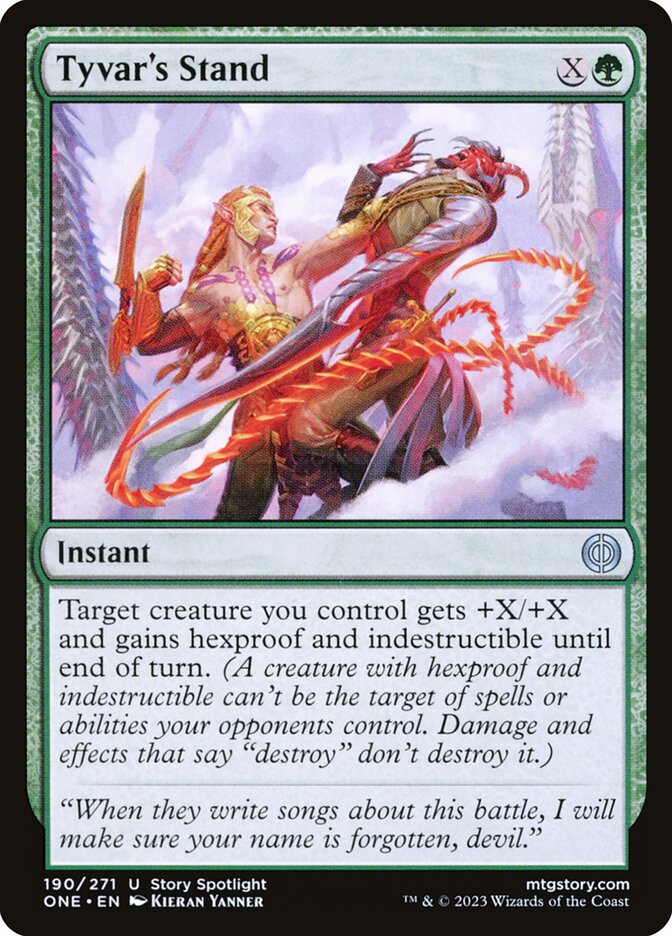
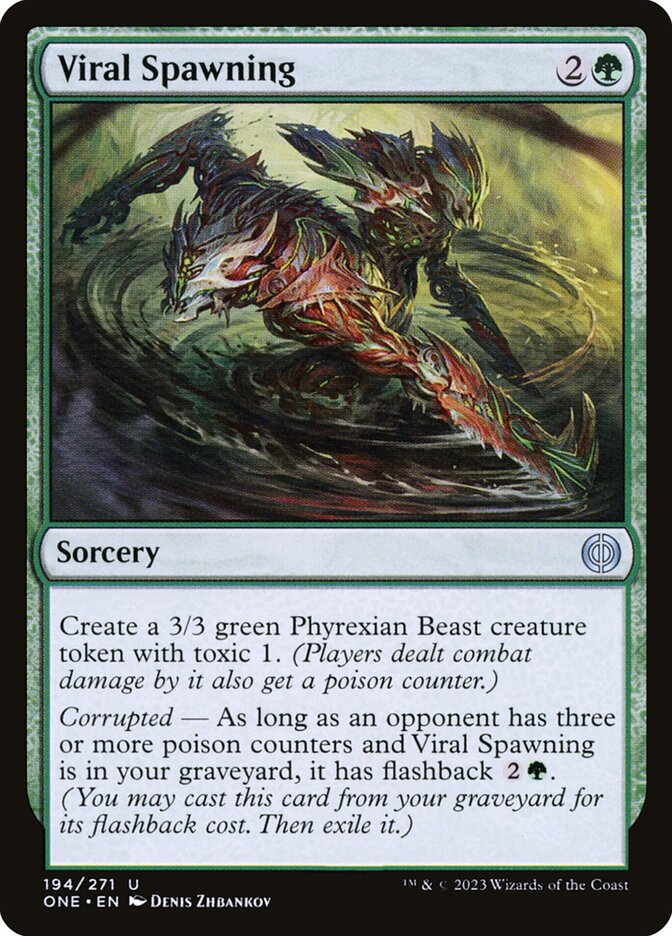
- Infectious Bite: An instant speed punch is wonderful; one that also moves your opponent 1/10th of the way towards death is amazing.
- Tyvar’s Stand: Neutering a removal spell with instant speed hexproof and indestructible can be enough to swing a game in your favor.
- Viral Spawning: A 3/3 with Toxic for three mana is a great rate; being able to summon its twin a little later in the game is just WOW.
IMPORTANT: This Section May Save Your Life!!
These creatures have reach:
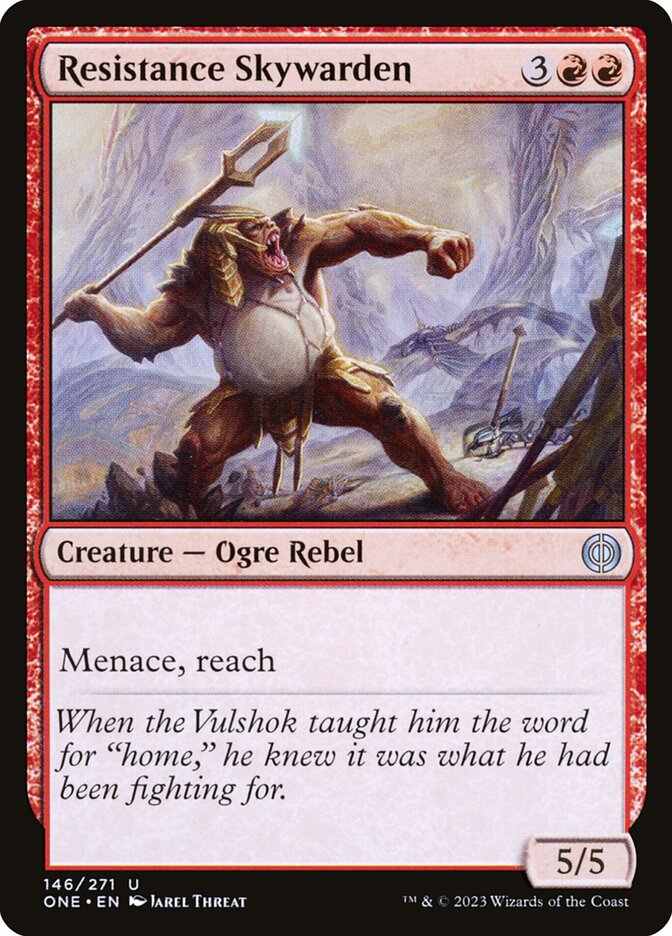
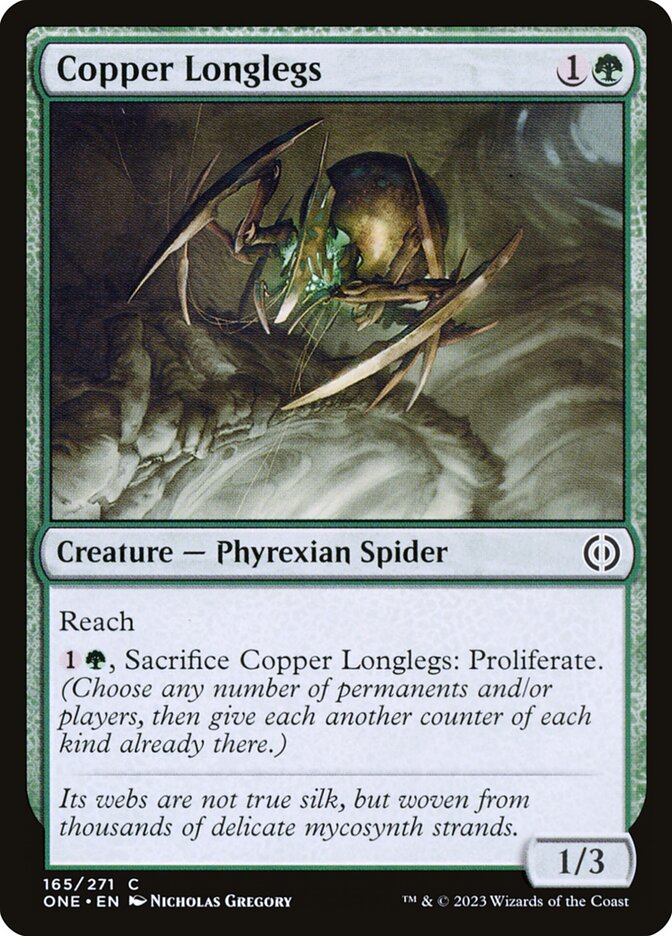
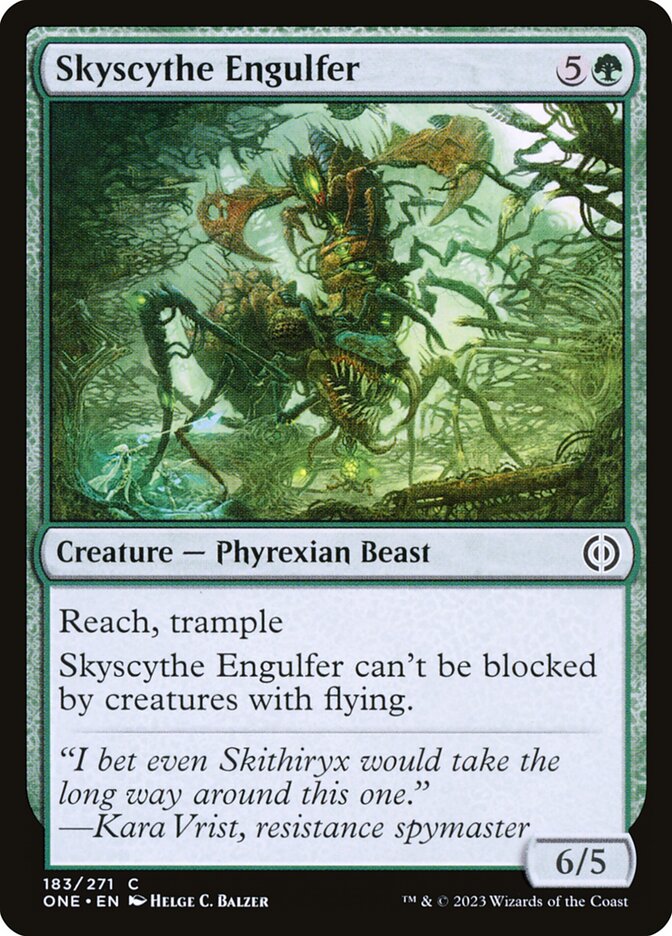
Be honest: how many of these creatures would you have blithely swung your flyer into? No, no need to thank me. You’re welcome!
Summation
Here’s what I’d keep in mind when playing Limited matches Phyrexia: All Will Be One.
- The biggest difference between ONE and other Limited formats is that there is a very viable alternative win condition in the form of poison counters. Poison creates an alternative clock that might not even be combat-based. That makes it harder to anticipate your opponent’s tactics and path to victory.
- Given that, it’s better to have a proactive strategy: aggro, poison, or oil counters. Fortunately eight of the color pairs have strong natural synergies (with White/Blue artifacts and Red/White Equipment aggro being categories all to themselves). That’s because every color has counter-based cards, whether it’s poison or oil counters, and Proliferate provides key support for both of these mechanics.
- Have you ever played a game of Limited where one person feels like they’re doing something completely busted (such as the Defender deck in Dominaria United)? I think ONE will have a higher-than-normal proportion of decks capable of busted games. Do your best to ensure that yours falls into that category.
Good luck!










